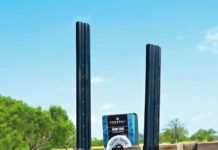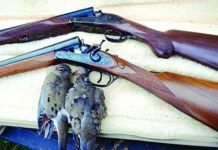The makers of Britain’s best side-by-sides have been known to wonder aloud why American shooters lean toward the over and under configuration. “I say, it’s not as though you chaps had eyes placed one above the other.” No, gentle-men. It’s because the side-by-side double has vanished, sadly, from the production lines of the major American manufacturers. It’s because of that sighting plane down the upper barrel and quick target acquisition. It’s because the over/under gets a second round off quicker than a pump and with less disturbance to the sight picture—be the target clay, feathered, or four-footed. All of which you know and prove by crafting such guns with exquisite precision.
Despite those and other advantages, the only American-made over/unders on the market are Ruger’s Red Label and Remington’s Peerless. The lowest cost Ruger retails at about $900, the Remington about $1,000. A sporting clays version of the Peerless lists at $2,500; a Woodside Red Label with Circassian walnut stock: $1,675. Less expensive by tens of thousands of dollars than a Purdy shotgun for certain, but still pricey enough to eliminate anyone mucking along with minimal, or fixed, disposable income. And top of the line imports, such as Beretta, don’t offer the pocketbook any relief.
So the challenge to the shooter is to find the over/under shotgun that delivers a quality shooting experience at a reasonable cost. This basic rationale governed our selection of the guns we included in the examination that follows. They hold the promise of the advantages of an over/under shotgun at a cost many shooters will find manageable.
There aren’t many over/under shotguns that retail for under $630, but we did manage to find two such imported hunting models. They were the Stoeger Condor I and the American Arms Silver I. We felt the less expensive Condor I was a better buy.
How We Tested
During this head-to-head test, each over/under was fed 100 rounds of commercial hunting loads. The ammunition used was Winchester Super-X No. 8 Small Game Hunter shotshells and Fiocchi No. 7 1/2 Field Loads. Most firing was done on a Skeet range from the usual shooting positions. Patterning was accomplished at 30 yards.
Here is what we found:
Stoeger Condor I
Stoeger’s line of double-barrel shotguns is made by IGA of Brazil. The Condor I is a no-frills over/under shotgun. The $559 20 gauge version of this model is equipped with extractors, instead of ejectors, and a single non-selective trigger. Its barrels, which are available in lengths of 26 or 28 inches, have 3-inch chambers and screw-in choke tubes.
Physical Description
Our Condor I wasn’t what we would call good looking, but its overall workmanship was acceptable for an over/under shotgun in this price range. All of its steel parts had a uniformly blued finish with a medium polish. Shallow tool marks were noted on the sides of the block at the rear of the barrels. The barrels were joined only at the front and rear, leaving the middle area open and unsupported.
The action was equipped with a two-piece stock made of Brazilian hardwood. Its hand-rubbed oil finish was evenly done, but the checkering had several overcuts. The vented 1-inch-thick black rubber recoil pad was slightly oversized. In wood-to-metal mating, no shortcomings were found. The removable forend locked securely in place.
Our Judgments
On the skeet range, this shotgun functioned as it should. Ignition was positive with the kinds of commercial shotshells we tried. The extractors pushed spent or live rounds backward 1/4 inch, which was far enough for us to grasp and remove them from the chambers. The action opened and closed with only a modest amount of effort on the shooter’s part.
Many wingshooters favor 20 gauge shotguns because they generally are lighter and slimmer than a 12 gauge model, making them easier to carry and faster handling. But, the Condor I’s weight and size were like those of the larger gauge guns.
We considered this Stoeger to be well-balanced, but it weighed about a pound more than the other scattergun tested. So, shouldering and swinging to the target were noticeably slower. However, felt recoil was milder and follow-up shots were significantly faster. The comparatively thin comb didn’t provide an especially comfortable cheek-to-stock fit, but it did afford a good view of the sighting plane.
Both of the Condor I’s controls worked smoothly and could be manipulated with the thumb of the shooter’s firing hand. When pushed to the right, the action release lever on the tang unlocked the barrel assembly and allowed it to be pivoted open. The manual safety, a two-position slide located behind the action release, engaged when moved to the rear.
This Stoeger had a non-selective mechanical trigger. This means that there was no way to change which barrel fired first. Furthermore, the mechanism for resetting the trigger between the first and the second pull was mechanical, instead of inertial. Mechanical systems are generally considered to be the most reliable, because they will reset even if the first barrel fails to fire. Inertia systems utilize the recoil forces generated when the first barrel fires to reset.
Ideally, both of the trigger pulls on a double-barreled should feel and weigh the same. But, this was not the case on the Condor I. Its first trigger pull released at 7 1/4 pounds, while the second released at 6 1/2 pounds. Both pulls had an above average amount of takeup.
In our opinion, this shotgun’s sighting system was very basic, but got the job done. It consisted of a ventilated 3/8-inch-wide by 26-inch-long barrel rib with a medium-size brass bead on the front. The top of the rib was serrated to prevent glare.
Two choke tubes, rated as Improved Cylinder and Modified, and a wrench were provided with the Condor I. Both chokes provided appropriate shot patterns that had fairly uniform pellet distribution with Fiocchi No. 7 1/2 Field Loads and Winchester No. 8 shotshells.
American Arms Silver I
The American Arms Silver I is a budget-priced over/under shotgun made in Brescia, Italy. This $625 model features extractors and a single selective trigger. In 20 gauge, its 26- or 28-inch barrels have 3-inch chambers and fixed chokes. The bores are hard chromed for corrosion resistance and longer barrel life.
Physical Description
In our opinion, the Silver I was much better looking than the Stoeger Condor I. Its receiver had a silver/white finish with leaf and flower engraving, while the remainder of the gun had a blued finish with a uniform, medium polish.
However, we thought its metal work was inconsistent. The action’s movement was extremely stiff. Tool marks were noted inside the receiver and on both sides of the barrel block. The top surface of the barrel block was unevenly contoured. On the positive side, the barrels were joined by a vented full-length rib.
The two-piece stock was made of nicely-grained walnut with a smooth semi-gloss finish. Its checkering was neatly cut. The vented 1/2-inch-thick black rubber recoil pad was slightly undersized. Wood-to-metal mating was very good. The removable forend locked solidly onto the gun.
Our Judgments
This American Arms digested everything we gave it without malfunctioning. But, the action was so hard to open and close that operating it required a lot of muscle, which our shooters felt was unsatisfactory even for an over/under shotgun in this price range. Unloading wasn’t difficult as the extractors pushed live or fired shotshells rearward 1/4 inch.
The well-balanced Silver I was lighter and slimmer than the Stoeger Condor I, as a 20 gauge model should be. Consequently, shouldering was easier and target acquisition was faster. Some of our shooters found the comfortably-shaped comb a little too high, so they had to press their face down onto the stock to obtain a good view of the sighting plane. Felt recoil was heavier than that of the other shotgun tested.
Like the action, operating the action release lever on the tang required an excessive amount of effort. Although its movement smoothed out a little by the end of the test, our shooters ended up with sore thumbs from repeatedly pushing the release to the right.
However, this shotgun’s other controls operated positively. The manual safety was a two-position slide on the tang behind the action release. It engaged when moved rearward, and could be manipulated by the shooter’s firing thumb. The barrel selector was a switch at the top front of the trigger. When it was in the left position, which was marked with a “U,” the bottom barrel fired first. In the right position, marked with an “O,” the top barrel fired first.
We considered the movement of the ungrooved 1/4-inch-wide trigger to be good. According our self-recording gauge, either of the two pulls released with 5 1/4 pounds of rearward pressure. Both had a moderate amount of slack.
The Silver I’s sights consisted of a vented 5/16-inch-wide barrel rib with a small brass bead in the middle and a large brass bead on the front. Our shooters said this system provided a well-defined sighting reference.
Our test gun’s two fixed chokes were rated as Improved Cylinder and Modified. They produced shot patterns that were more than satisfactory with Fiocchi No. 7 1/2 Field Loads, but pellet distribution was spotty when using Winchester Super-X No. 8 Small Game Hunter shotshells.































I have one I’m trying to find more about it if I could get some help it would be greatly appreciated